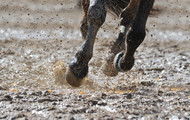Treating the causes of Mud Fever in Horses
Posted by Darren Walton on 28th Aug 2021
Mud Fever In Horses
With increasingly wet winter and spring periods across the UK horses are becoming more and more at risk from developing mud fever. Mud fever causes irritation, soreness and scabs which form on the lower part of the leg. Mud fever is also commonly referred to as dermatitis, cracked heels or greasy heels. You may also see matting of the hair on the leg in affected horses.
Generally mud fever forms on the pastern and the heel. While not contagious (does not spread to people or from horse to horse), mud fever can be painful and the horse may not tolerate being touched in affected areas. Pink skin, under white legs can be more commonly affected than dark skin. In severe cases you may see a swelling of the leg where infections develop underneath the scabs.
Mud fever is generally caused by bacterial infection. It is most common in the winter months when the horse is exposed to longer periods of wet and muddy conditions. The wet conditions cause the skin to soften, the mud then abrades the surface of the softened skin allowing bacteria to enter. Other causes can include leg mite, whereby the bacteria enters the skin where the mite infestation has broken the surface. Heavily feathered horses are more susceptible to leg mite and veterinary advice should be sought if you believe your horse has leg mite. Common signs are stamping the legs due to the irritation caused by the mite.
Conditions which increase the risk of Mud Fever should ideally be avoided. These include the horse having to stand in wet and muddy pastures, stand in dirty bedding, washing the legs too frequently and not thoroughly drying them, having broken or damaged skin on the legs due to injury. Horses with thin skin such as Thoroughbreds or Arabs are more at risk as are any animals with an already weakened immune system eg Horses with Cushings. For horses with underlying conditions it is vital to try and prevent mud fever as it can be much more difficult to treat in these animals.
In order to protect your horse from Mud Fever, knowing the usual appearance of your horses legs is essential – so that you can spot any changes and identify Mud Fever early. It is therefore suggested that you check the animals’ legs every day. It is much easier to manage the condition if it is caught early. You can get further advice from our pharmacists or buy products to prevent and aid mud fever from our pharmacy.
Typical signs include:
- Broken & damaged skin.
- Matted hair or patches of hair loss.
- Discharge between the skin & the scabs – usually yellow, white or green in colour.
- Pain, heat or swelling in the lower limbs.
- Crusty scabs on the lower legs or heels.
- Lameness in severe cases.
Diagnosis of mud fever should always be carried out by your veterinary surgeon to rule out other conditions with similar symptoms. Managing the condition once diagnosed is relatively straightforward.
- Horses should be brought in, away from the wet and muddy conditions where you can keep their skin clean and dry.
- Removing the scabs allows easier access to the skin and allows the air to reach the skin beneath to promote healing. However, removing the scabs can understandably be uncomfortable for the horse. Only remove loose scabs and do not forcibly remove them unless advised to do so by the vet. There are products to help soften the scabs.
- Affected areas should be cleaned twice daily with an effective disinfectant and then patted dry with a clean towel.
- Applying a stable bandage can help reduce swelling, keep the area clean and provide support.
- In heavily feathered horses the area may need to be clipped.
- If a mite infestation has triggered the condition the mite infection needs to be treated.
- In some cases, once the initial infection is controlled, it may be necessary to apply a barrier cream to prevent repeat re-infection.
If your horse does not respond to this management of the condition then it is essential to seek further advice from your veterinary surgeon who can prescribe a suitable treatment plan.
As with most conditions, prevention is certainly better than cure. By addressing the underlying causes of Mud Fever you can help prevent the condition in the first place:
- Ensure your horse is not standing in wet, muddy conditions all day where possible – ensure there is at least an area where your horse can stand out of the mud and wet for parts of the day.
- Fence off muddy areas where possible.
- Put down hardcore in areas where horses gather such as water troughs and gateways.
- Avoid washing legs – wait until the mud dries and then brush off. If this is not possible ensure the legs are dried thoroughly after washing.
- Inspect your horses’ legs every day.
- Treat any underlying conditions such as mite infestations or wounds.
- Use of specially designed turnout boots specifically designed to prevent mud fever.
- Use a suitable barrier cream – this provides a barrier between your horses’ skin and the bacteria.
- If your horse has underlying health issues which affect its immune system discuss a suitable course of action with your vet.
Owners should also be aware that Mud Fever can occur in other areas, generally along the back or on the belly where it is known as rain scald. The prevention methods and treatment actions for this are effectively the same as treating Mud Fever.

